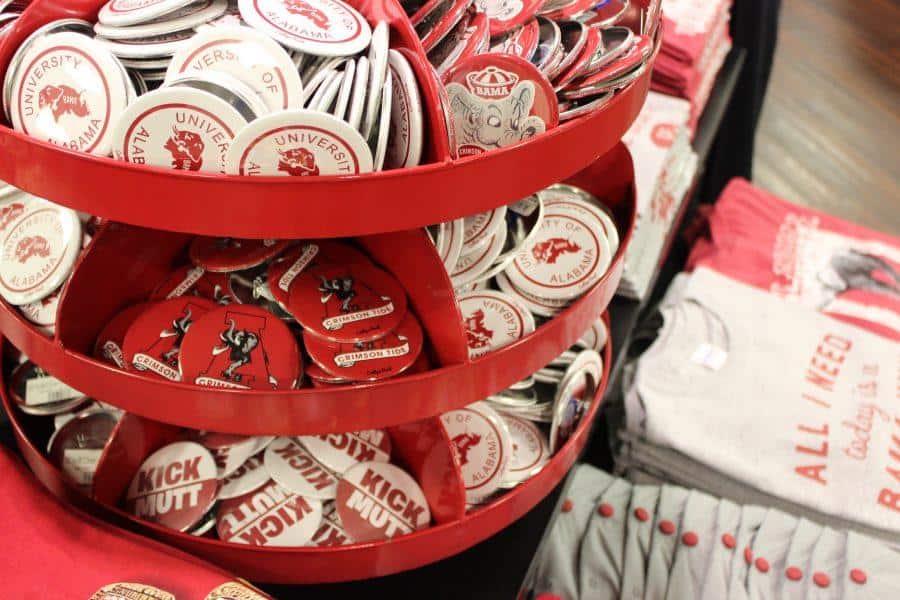What you wear can say a lot about you. Whether it’s a t-shirt bearing Greek letters or a piece of monogrammed jewelry, chances are you’re toting something around that emits information to passers-by.
Buttons, often clipped to clothing on gamedays or stitched to backpacks, have the ability to express personality and group identification in the same way a nametag tells strangers your name. One notable example is the expressive button adorned by many on Saturdays, depicting Coach Nick Saban’s animated face.
The button culture on campus is one that spans from student group advertising accessories to political campaigning tools. Students wear them to express themselves or as a way of identifying their affiliation with a group or groups around campus.
Anna Greene, a junior majoring in communicative disorders, sees gameday buttons offten as a Crimsonette, with her parents donning a button with her face on it each Saturday. Greene explained her parents do this for her, and in the past for her sister, as a show of support.
“People used to wear pins and buttons a lot, but over the years they have lost their appeal,” Greene said. “Recently, I think buttons have become a thing as a form of support. I think buttons are good for gameday, but I don’t know that I would wear one during the week.”
Some students believe that buttons are a sense of identity and a way of expressing your participation in certain groups, whether they be the college you are in, or an organization you represent. They have the ability to efficiently express opinions and affiliations in an instant.
Shae Brown, a senior majoring in early childhood education, works at the new corner SupeStore and occasionally sells the buttons that the university creates for students. Brown explained that if she were to put anything on a button, she would use the button as a means of supporting a cause or a group.
“If it was for a certain cause, the button would somehow represent that cause or an organization,” Brown said. “Probably for colleges and more organizations besides greek, such as ‘HES Loves the Tide’ or ‘MDB Loves the Tide’.”
Buttons give a voice to organizations that aim to increase their visibility around campus. With more button support around campus, organizations can encourage more students to participate, or show that other organizations might benefit with the creation of a button.
One student is an avid collector of buttons from all over the country. Kendra Gillberg, a sophomore majoring in restaurant and hospitality management, is an avid collector, and her current lineup rounds out at 132 buttons from colleges around the country from certain conferences she has attended. But the vast majority are UA buttons. Her collection began as a means of trading and collecting items while out of town for conferences with other universities.
“I realized I didn’t have any t-shirts to trade at the swaps they have, so I began collecting buttons to trade instead,” Gillberg said. “After that, people began to comment on the fact that I had so many buttons and it just kind of became the thing for me to do.”
Buttons do not all serve the same purpose, but they serve their individual purposes by using clever phrases or humorous quips taken from the Crimson Tide culture, or even pop culture references.
Buttons shared via the students referenced in this article included pictures of Nick Saban’s face, “Crimsonettes Love the Tide”, and another that says, “I’ve got 99 problems and 86 are hypothetical situations in my head that I’m stressing about for no particular reason.”
The opportunities for creating buttons are endless, and the culture for buttons on campus has created a space where students can put their ideas to use and produce their own voice in the form of a button.
Some students create their own ideas and put them on buttons to try and sell on campus, whether they are humorous or gameday related. Students, similar to Gillberg, are on the lookout for the next best button, and everyone has the potential to be its creator.
Other groups, like the Health Hut, have new buttons each week to keep up with their weekly goals and messages. Groups camp out near or inside the Ferguson Center to offer buttons to students walking in and out, with the hopes of spreading their physical word of mouth like a wildfire.
“I think buttons developed from the same vein that bumper stickers and computer decorations have,” Gillberg said. “They are simple and entertaining, but they still make a point about something in a few short words.”









